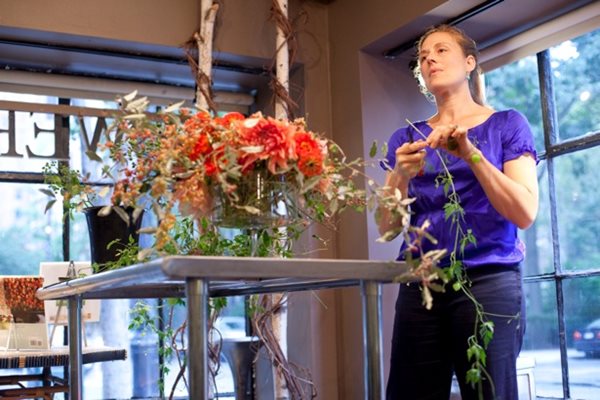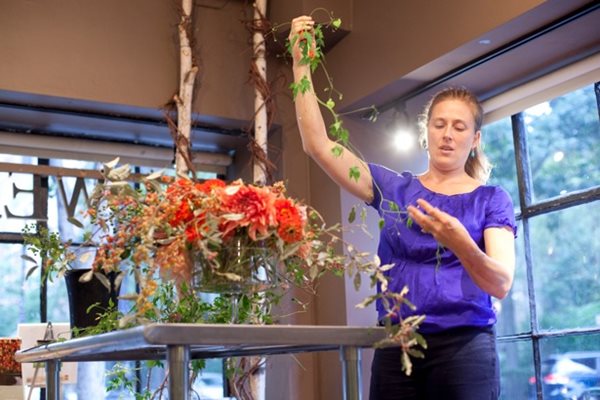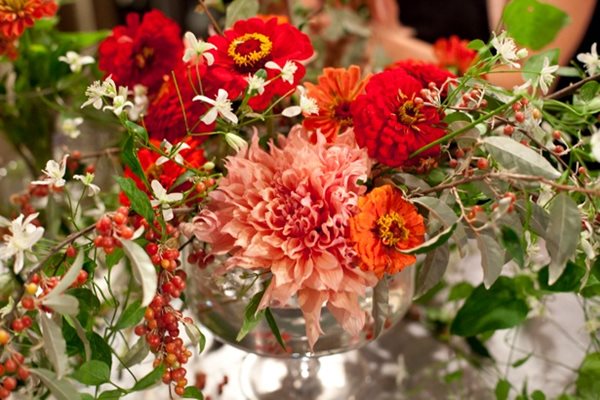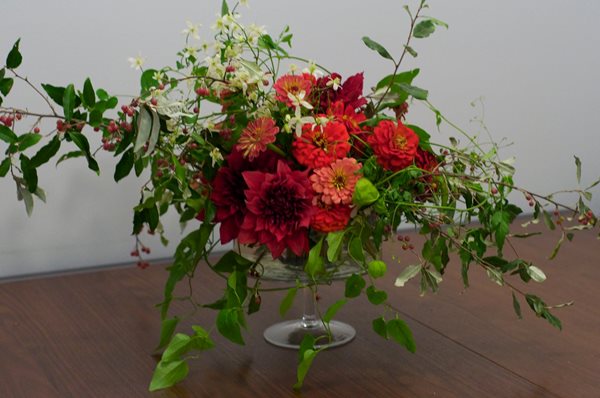FlowerSchool New York: Master Class with Ariella Chezar
Our online editor attends a class taught by florist Ariella Chezar and share some of Chezar's tips for creating a natural, full but loose centerpiece. Chezar favors a more relaxed style of arranging that is inspired by the way plants grow in the garden and is a move away from the tightly bundled style of flower arranging.

Last week, I had a chance to take a class with Ariella Chezar at New York's FlowerSchool. Located on the far east side of Midtown Manhattan, tucked inside a pretty ground-floor studio, the school offers classes with well-known florists for students of every level.
As the online editor of GardenDesign.com, I often edit and read our articles about flower arranging, but sometimes, I must admit, my theoretical knowledge outstrips my actual knowledge. So I was thrilled to be able to be able to put some of my book learning to use in this class. Almost all of my fellow students were florists, so I was the amateur among pros, but I had a great time. I've put together a slide show with some tips and thoughts about how you can recreate some of Chezar's style at home.
Left: Ariella Chezar (left) with Eileen Johnson, founder of FlowerSchool.

Chezar is known for her natural and loose style of flower arranging, popular with brides across the country. Raised in the Berkshires, she moved back to her family home in 2003. She described being inspired by the plants on the side of the road and in her garden and how she uses all of these natural elements as inspiration for her arrangements.
Tip: For natural-looking arrangements, avoid using Oasis flower foam if possible, says Chezar. Floral foam, she points out, can hold flower stems at any angle, often resulting in stiff and artificial-looking displays of flowers. For this arrangement, she uses a flower frog attached to the bottom of the footed compote with florist sticky clay.

As part of her arrangement, Chezar began weaving love-in-a-puff (Cardiospermum halicacabum) vines through her arrangement.
Tip: Look around your garden for unexpected elements that add a wild quality to your flower arrangements.

We, the students, listen intently.
Most of my fellow students are wedding florists and it is interesting hearing what the trends are around the country. Jane Guerin, who was working next to me at my table, and a wedding florist in Virginia, confided that the economy was still affecting wedding budgets and that Chezar's looser style of centerpieces had not yet become widespread among florists in her area. On the other hand, "brides," Guerin said, "just want whatever they see in magazines." And Chezar's style has definitely become more popular in wedding magazines and blogs.
Tip: Many florists in the class mentioned the difficulty of producing lush, expansive centerpieces for clients with smaller budgets. Chezar suggested using a mix of more inexpensive flowers along with the pricier blooms, giving a particular shout-out to carnations as an often overlooked flower.

Each student gets a footed compote vase, with a flower frog attached to the bottom with florist sticky clay.
Tip: Chezar says, "The green sticky clay works better than the white."

For our class arrangements, we used dahlias, zinnias, Russian olive (Elaeagnus angustifolia), small white clemantis, and love-in-a-puff (Cardiospermum halicacabum). Love-in-a-puff is named for the seeds inside the puffs (that are actually the fruit of the vine), which are each marked with a little white heart.
Tip: GardenDesign.com recently published a great slide show from Katherine Anderson, the florist behind Marigold and Mint in Seattle, about arranging zinnias and dahlias, which also happened to feature the same colors of dahlias and zinnias used by Chezar.

Chezar comes around to offer suggestions for students' arrangements.
Tip: Chezar suggests starting with creating an inverted triad with the branches and then placing the other greenery in the arrangement. This creates a more natural, 360 degree look for centerpieces. She also suggests buying an inexpensive lazy susan, so you can easily spin an arrangement, to make sure that it is attractive to the eye from all angles.

Dahlias can be quite fragile, but their beauty is worth it. Chezar quotes Shakespeare, saying "When I consider every thing that grows /
Holds in perfection but a little moment," about the dahlias.
Tip: For a relaxed garden-style arrangement, once you begin to fill in with flowers, leave the center open, to help prevent the tight, domed look of a more traditional arrangement. Fill in the center part of the arrangement at the end, keeping the low, overall shape of the arrangement.

Here I am, hard at work.
Tip: If the branches are tough to stick into the frog, slit the bottom of the branches so that it is easier for them to grab onto the pins.

A student's finished arrangement.
I enjoy seeing how all of the students have their own style, even when using the same flowers and vases.
Tip: Try to arrange the flowers so that the back of the blooms are not overly visible.

Another student's arrangement.
Tip: Don't be afraid of letting parts of the arrangement touch the table.

A final creation is ready for its close-up.
Tip: Try to keep your flowers in the same color family.

My arrangement at home, after a long, bumpy taxi ride!
Tip: To transport arrangements, line cardboard boxes with tissue paper, to try to avoid bruising the flowers and leaves.




